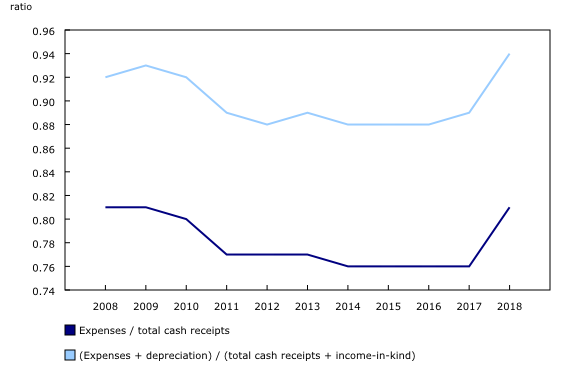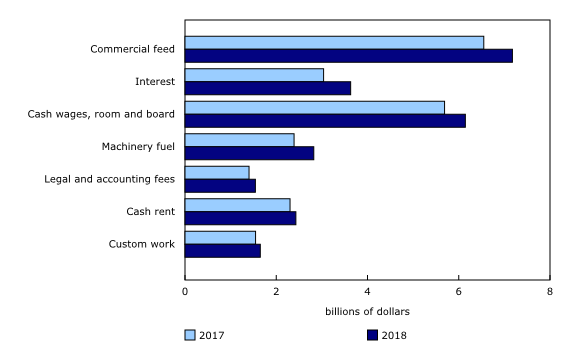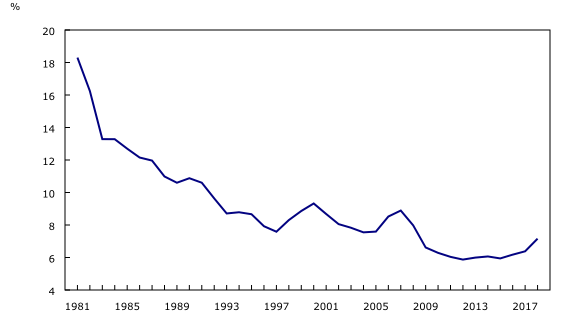Farm income, 2018
Archived Content
Information identified as archived is provided for reference, research or recordkeeping purposes. It is not subject to the Government of Canada Web Standards and has not been altered or updated since it was archived. Please "contact us" to request a format other than those available.
Released: 2019-05-28
The realized net farm income of agricultural producers fell 45.1% in 2018 to $3.9 billion, the largest percentage decrease since 2006. This followed a 2.8% decline in 2017.
Realized net income is the difference between a farmer's cash receipts and operating expenses, minus depreciation, plus income in kind.
Rising feed, interest and labour costs together with little change in farm cash receipts pushed realized net farm income lower.
Realized net income fell in every province except New Brunswick (+7.2%) where an increase in cannabis and potato production boosted receipts. More than one-third of the national decrease was attributable to a 68.1% decline in Alberta.
Little change in farm cash receipts
Farm cash receipts, which include crop and livestock revenues as well as program payments, edged up 0.1% to $62.2 billion in 2018. This followed a 2.6% rise in 2017.
Farm cash receipts declined in five provinces, with the largest drop in Alberta (-4.0%), while New Brunswick, Quebec, Ontario and British Columbia posted gains.
Market receipts totalled $60.0 billion in 2018, up 0.4%, as a small rise in crop receipts more than offset a small drop in livestock receipts.
Market receipts are the product of price and marketings. Marketings are quantities sold, using various units of measure.
Increases in wheat and cannabis receipts lead to slight rise in crop receipts
Crop revenue edged up 0.9% to $35.0 billion in 2018 as increases in wheat (excluding durum) and cannabis revenues more than offset a decline in canola receipts.
Wheat (excluding durum) receipts were up 11.6%—the second consecutive annual double-digit increase. Both prices and quantities sold rose, as exports to China almost tripled.
The revenue of licensed cannabis producers totalled $564.1 million in 2018, up from $189.0 million in 2017. The recreational use of cannabis became legal in October 2018, contributing to the 198.4% hike in receipts.
Receipts for corn producers increased 9.9% on rising prices and marketings.
The 6.5% decline in canola receipts was driven by decreased marketings as exports were down. Canola producers in Alberta were especially hard hit as canola receipts decreased 16.1%. Marketings fell by a similar percentage, in the wake of rail disruptions early in the year, a late harvest and lower production.
Falling prices pushed lentil revenues down 35.1%. The imposition of duties by the Indian government in late 2017 on imports of lentils curtailed exports, sharply lowering prices. These duties also applied to dry peas with similar results. Dry pea revenue fell 19.7% as prices declined 17.2%.
Falling hog receipts push livestock receipts down slightly
Revenue from livestock production edged down 0.2% to $25.0 billion in 2018.
Hog receipts were down 8.9% on lower prices as North American inventories reached record highs in 2018. Retaliatory pork tariffs imposed on the United States by China and Mexico also contributed to the surplus of hogs in the United States, reducing demand for Canadian exports.
Moderating the decline in livestock revenue was a 2.8% rise in the receipts of supply-managed commodities. Chicken receipts were up 5.9%, with both prices and quantities sold increasing.
There was little change in the cattle and calf sector, with receipts edging up 0.1% as small price decreases were more than offset by higher marketings.
Program payments to producers fell 8.9% to $2.2 billion in 2018. Crop insurance payments were down 27.2%, following a 17.3% rise in 2017.
Biggest increase in farm expenses in six years
Farm operating expenses (after rebates) increased 6.5% in 2018 to $50.6 billion—the largest percentage increase since 2012.
Feed costs were up 9.6%, largely due to rising prices as feed grain supplies were tight prior to harvest. A large influx of imported corn from the United States provided an alternative source of feed.
Interest expenses (+19.5%) increased sharply on rising average interest rates (+10.0%) and debt levels (+8.7%). This was the largest increase in interest expenses since 1981 (+49.5%). While in 1981 interest expenses comprised a large share of total operating expenses (18.3%), this was not the case in 2018 when the interest share increased to 7.2%, up from 6.4% in 2017.
Cash wages increased 8.0% in 2018—well above the average increase of the previous five years (+3.5%). Increased cannabis production and the impact on the horticultural sector of minimum wage legislation in Ontario strengthened the wage hike.
Higher prices pushed machinery fuel expenses up 18.1% in 2018. This followed a price-related 9.3% hike in 2017.
Total farm expenses—the sum of operating expenses and depreciation costs—rose 5.9% to $58.4 billion in 2018 as depreciation charges increased 2.2%.
Total farm expenses were up in every province, ranging from increases of 3.9% in Newfoundland and Labrador to 14.0% in New Brunswick.
Sharp decline in total net income
Total net farm income fell $5.2 billion to $3.0 billion in 2018.
Total net farm income is realized net income adjusted for changes in the farmer-owned inventories of crops and livestock. It represents the return to owner's equity, unpaid farm labour, management and risk.
Lower on-farm stocks of barley, corn, wheat (excluding durum) and soybeans as well as decreased cattle and calf inventories contributed to the drop in the value of inventory change (-$865 million).
All provinces recorded declines in total net farm income.
Note to readers
Realized net income can vary widely from farm to farm because of several factors, including the farm's type of commodities, prices, weather and economies of scale. This and other aggregate measures of farm income are calculated on a provincial basis employing the same concepts used in measuring the performance of the overall Canadian economy. They are a measure of farm business income, not farm household income.
Additional financial data for 2018, collected at the individual farm business level using surveys and other administrative sources, will be made available later this year. These data will help explain differences in the performance of various types and sizes of farms.
Preliminary farm income data for the previous calendar year are first released in May of each year, five months after the reference period. Revised data are then released in November of each year, incorporating data received too late to be included in the first release. Data for two years prior to the reference period are also subject to this revision.
For details on farm cash receipts for the first quarter of 2019, see the "Farm cash receipts" release in today's Daily.
Contact information
For more information, or to enquire about the concepts, methods or data quality of this release, contact us (toll-free 1-800-263-1136; 514-283-8300; STATCAN.infostats-infostats.STATCAN@canada.ca) or Media Relations (613-951-4636; STATCAN.mediahotline-ligneinfomedias.STATCAN@canada.ca).
- Date modified:






